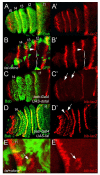Tarsal-less peptides control Notch signalling through the Shavenbaby transcription factor
- PMID: 21527259
- PMCID: PMC3940869
- DOI: 10.1016/j.ydbio.2011.03.033
Tarsal-less peptides control Notch signalling through the Shavenbaby transcription factor
Abstract
The formation of signalling boundaries is one of the strategies employed by the Notch (N) pathway to give rise to two distinct signalling populations of cells. Unravelling the mechanisms involved in the regulation of these signalling boundaries is essential to understanding the role of N during development and diseases. The function of N in the segmentation of the Drosophila leg provides a good system to pursue these mechanisms at the molecular level. Transcriptional and post-transcriptional regulation of the N ligands, Serrate (Ser) and Delta (Dl) generates a signalling boundary that allows the directional activation of N in the distalmost part of the segment, the presumptive joint. A negative feedback loop between odd-skipped-related genes and the N pathway maintains this signalling boundary throughout development in the true joints. However, the mechanisms controlling N signalling boundaries in the tarsal joints are unknown. Here we show that the non-canonical tarsal-less (tal) gene (also known as pri), which encodes for four small related peptides, is expressed in the N-activated region and required for joint development in the tarsi during pupal development. This function of tal is both temporally and functionally separate from the tal-mediated tarsal intercalation during mid-third instar that we reported previously. In the pupal function described here, N signalling activates tal expression and reciprocally Tal peptides feedback on N by repressing the transcription of Dl in the tarsal joints. This Tal-induced repression of Dl is mediated by the post-transcriptional activation of the Shavenbaby transcription factor, in a similar manner as it has been recently described in the embryo. Thus, a negative feedback loop involving Tal regulates the formation and maintenance of a Dl+/Dl- boundary in the tarsal segments highlighting an ancient mechanism for the regulation of N signalling based on the action of small cell signalling peptides.
Copyright © 2011. Published by Elsevier Inc.
Figures






Similar articles
-
dAP-2 and defective proventriculus regulate Serrate and Delta expression in the tarsus of Drosophila melanogaster.Genome. 2007 Aug;50(8):693-705. doi: 10.1139/g07-043. Genome. 2007. PMID: 17893729
-
Composite signalling from Serrate and Delta establishes leg segments in Drosophila through Notch.Development. 1999 Jul;126(13):2993-3003. doi: 10.1242/dev.126.13.2993. Development. 1999. PMID: 10357942
-
Sequential Notch signalling at the boundary of fringe expressing and non-expressing cells.PLoS One. 2012;7(11):e49007. doi: 10.1371/journal.pone.0049007. Epub 2012 Nov 12. PLoS One. 2012. PMID: 23152840 Free PMC article.
-
Cell and molecular biology of Notch.J Endocrinol. 2007 Sep;194(3):459-74. doi: 10.1677/JOE-07-0242. J Endocrinol. 2007. PMID: 17761886 Review.
-
Delivering the lateral inhibition punchline: it's all about the timing.Sci Signal. 2010 Oct 26;3(145):pe38. doi: 10.1126/scisignal.3145pe38. Sci Signal. 2010. PMID: 20978236 Review.
Cited by
-
Pri peptides temporally coordinate transcriptional programs during epidermal differentiation.Sci Adv. 2024 Feb 9;10(6):eadg8816. doi: 10.1126/sciadv.adg8816. Epub 2024 Feb 9. Sci Adv. 2024. PMID: 38335295 Free PMC article.
-
The pleiotropic functions of Pri smORF peptides synchronize leg development regulators.PLoS Genet. 2023 Oct 30;19(10):e1011004. doi: 10.1371/journal.pgen.1011004. eCollection 2023 Oct. PLoS Genet. 2023. PMID: 37903161 Free PMC article.
-
Primitive Phospholamban- and Sarcolipin-like Peptides Inhibit the Sarcoplasmic Reticulum Calcium Pump SERCA.Biochemistry. 2022 Jul 19;61(14):1419-1430. doi: 10.1021/acs.biochem.2c00246. Epub 2022 Jun 30. Biochemistry. 2022. PMID: 35771007 Free PMC article.
-
Mass Spectrometry-Based Peptide Profiling of Haemolymph from Pterostichus melas Exposed to Pendimethalin Herbicide.Molecules. 2022 Jul 21;27(14):4645. doi: 10.3390/molecules27144645. Molecules. 2022. PMID: 35889523 Free PMC article.
-
Planar cell polarity controls directional Notch signaling in the Drosophila leg.Development. 2012 Jul;139(14):2584-93. doi: 10.1242/dev.077446. Development. 2012. PMID: 22736244 Free PMC article.
References
-
- Artavanis-Tsakonas S, Rand MD, Lake RJ. Notch signaling: cell fate control and signal integration in development. Science. 1999;284:770–6. - PubMed
-
- Bailey AM, Posakony JW. Suppressor of hairless directly activates transcription of enhancer of split complex genes in response to Notch receptor activity. Genes Dev. 1995;9:2609–22. - PubMed
-
- Becam I, Fiuza UM, Arias AM, Milan M. A role of receptor Notch in ligand cis-inhibition in Drosophila. Curr Biol. 2010;20:554–60. - PubMed
-
- Bishop SA, Klein T, Arias AM, Couso JP. Composite signalling from Serrate and Delta establishes leg segments in Drosophila through Notch. Development. 1999;126:2993–3003. - PubMed
Publication types
MeSH terms
Substances
Grants and funding
LinkOut - more resources
Full Text Sources
Molecular Biology Databases
Miscellaneous

